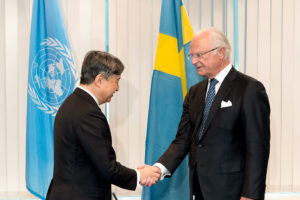6 tips that help you create the perfect World Water Week session
How do you create the perfect World Water Week session? If you are working on a proposal to host an event during this year’s Week, we have compiled some helpful tips. Adrian Puigarnau, who has been in charge of the programme for the past seven years, shares his insights into what participants really want.
It is the great content that has made World Water Week the leading annual water event. On 25 January we opened the Call for proposals, inviting high-profile organizations from across the world to submit their best session ideas. If you apply before 7 March, you can enjoy our special Early-Bird price.
Here are 6 tips that help you develop an inspiring session.
1. Focus on action
Impact and results are very important to World Water Week participants, according to our surveys. More than 80 per cent say they have taken a concrete action as a result of attending the Week. When planning your session, make it as action oriented as possible, with a focus on solving problems rather than just describing them. This is also something we look at when reviewing proposals – we suggest that you spend 20 per cent of the application on framing the problem and 80 per cent describing how you contribute to the solution.
2. Share news and trends
World Water Week participants are curious and interested in new ideas and trends. In these turbulent times, this is probably truer than ever. When selecting proposals, we specifically look for new thinking, findings, and approaches. Topics that generate new solutions or contribute to contemporary debates are especially encouraged. Also remember that World Water Week is the perfect platform for your organization to present your new publication, statement, or project.
3. Write interesting session descriptions
Attracting participants to your session starts with a great session description. Describe why people should join you and what they can expect, with as concise information as possible. Try to give details about what participants will learn. Explain the topic as simply and clearly as possible and mention if you expect your audience to have some prior knowledge of the topic.
The title should be short and inviting. Test it on a few people representative of the audience you want to attract.
4. Follow the Gold Standard
Many people are fascinated by the diversity of the World Water Week crowd – where else do you mix with people from more than 130 countries? Participants expect sessions with representation from different regions, with panelists and speakers of all ages and a good gender balance. To succeed, make sure to adhere to our Gold Standard which encourages inclusion and innovation. Around one-third of participants are under 35 and we are getting close to an even gender balance.
5. Choose great speakers
When participants consider whether to join a session, the quality of the speakers is described as one of the most important factors. Generally, the more well-known speakers are, the easier it is to attract an audience. But what is most important is to invite interesting speakers with something to say. People want to hear others share their own lived experiences. Choose speakers with care and try to include information about them in the session description.
When preparing the event, share good presentation techniques with your speakers and help them to focus their presentations on what is relevant to the audience. Try to avoid unnecessary repetition and to provide context that is already known to everyone – skip ahead to what is new.
6. Be welcoming!
World Water Week has gained a reputation as an unusually friendly and down-to-earth conference where it is easy to expand your knowledge and network. All participants and organizers are expected to follow our Code of Conduct. We all have a lot to learn from each other, especially from people with experiences very different from our own.
Remember that World Water Week is a very diverse conference and not everyone is a water expert. The audience will love helpful explanations and a bit of context that can make it easier for them to follow the session. Make everyone feel welcome.








